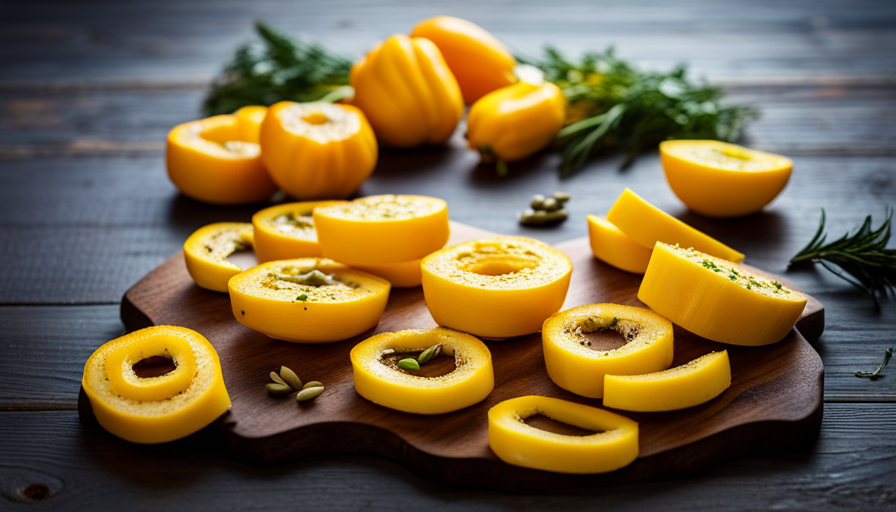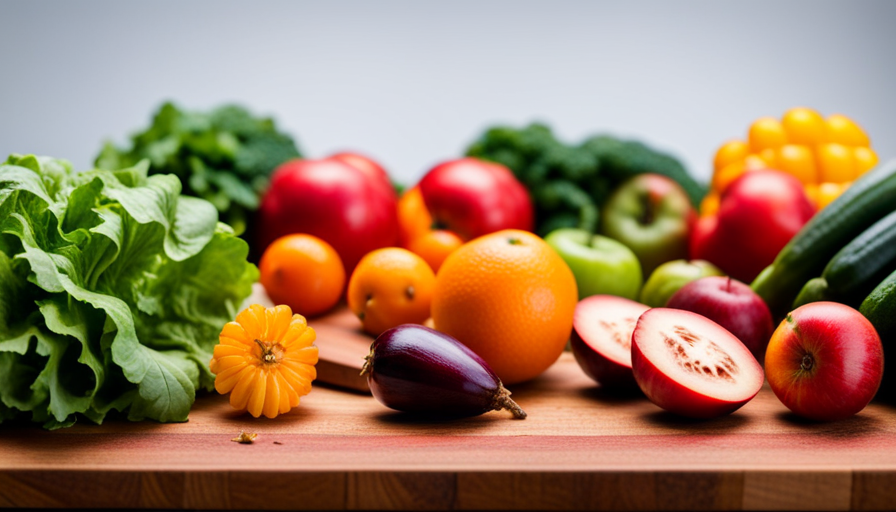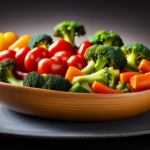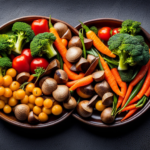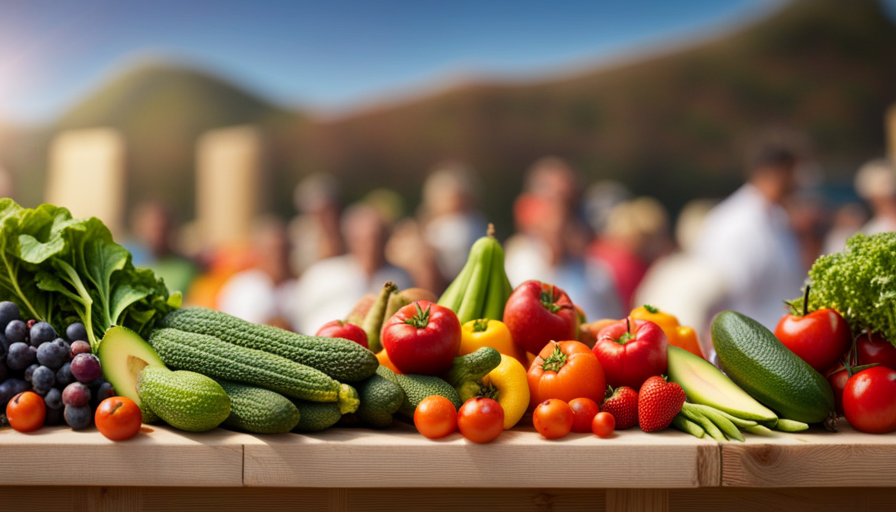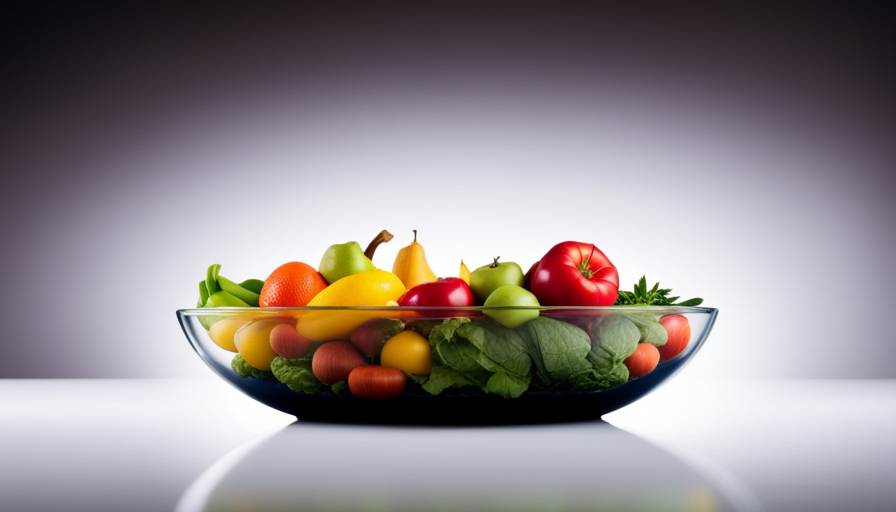Are you prepared to incorporate a pop of lively flavor and amazing health advantages into your raw food selection? Look no further than the adaptable yellow squash! This modest vegetable, with its vibrant yellow skin and delicate flesh, is packed with nutrients that can take your raw food experience to the next level.
From salads to smoothies, soups to salsas, the possibilities are endless when it comes to incorporating raw yellow squash into your meals. In this article, we will show you how to select, store, and prepare yellow squash for raw consumption. We’ll also provide you with a simple salad recipe, ideas for marinating and seasoning, as well as creative ways to use yellow squash in dips, soups, and wraps.
Get ready to tantalize your taste buds and nourish your body with the raw goodness of yellow squash!
Key Takeaways
- Raw yellow squash can be used in a variety of dishes such as salads, smoothies, soups, and salsas.
- Yellow squash is packed with nutrients including vitamins A, C, and B6, magnesium, potassium, and fiber.
- It can be prepared for raw consumption by slicing it into thin rounds or made into ‘noodles’ for raw dishes.
- Adding yellow squash to smoothies and juices provides a boost of vitamins and minerals and supports overall health and well-being.
Health Benefits of Raw Yellow Squash
Raw yellow squash is packed with nutrients that can boost your health and provide you with a vibrant and energetic lifestyle. Incorporating raw yellow squash into your diet can provide numerous health benefits.
One way to enjoy the goodness of raw yellow squash is by using it in raw desserts. Its mild flavor and tender texture make it a perfect addition to sweet treats like raw yellow squash smoothies or raw yellow squash puddings.
Not only does raw yellow squash add a refreshing taste to your desserts, but it also offers a wide range of nutrients. It’s rich in vitamins A, C, and B6, as well as magnesium, potassium, and fiber. These nutrients contribute to a strong immune system, healthy digestion, and glowing skin.
Another way to reap the benefits of raw yellow squash is by juicing it. Yellow squash juice is a refreshing and hydrating beverage that can provide a quick burst of nutrients. It’s a great source of antioxidants, which help protect your body from harmful free radicals and reduce inflammation.
Incorporating raw yellow squash into your diet can be as simple as adding it to your salads, stir-fries, or even eating it raw as a snack. With its numerous health benefits, it’s easy to see why raw yellow squash should be a staple in your raw food diet. So go ahead and enjoy the goodness of this versatile and nutritious vegetable!
Selecting and Storing Fresh Yellow Squash
When choosing and keeping fresh yellow squash, it’s important to consider its firmness and vibrant color. Select squash that feels firm when gently squeezed, avoiding any that have soft spots or blemishes. Look for a bright yellow color, as this indicates freshness. Keep in mind that smaller squash tend to be more tender and flavorful than larger ones.
To preserve yellow squash, store it in the refrigerator in a plastic bag or airtight container. This will help retain its moisture and prevent it from drying out. However, avoid washing the squash until you’re ready to use it, as moisture can promote spoilage.
When it comes to cooking techniques for yellow squash, there are several options to consider. One popular method is to slice the squash into thin rounds and sauté them in olive oil with garlic and herbs. This brings out their natural sweetness and creates a delicious side dish. Another option is to grate the squash and use it as a base for fritters or pancakes. Yellow squash can also be spiralized to make ‘noodles’ that can be used as a healthy alternative to pasta.
Selecting and storing fresh yellow squash is crucial to preserving its quality. By following these tips and using various cooking techniques, you can enjoy the flavors and health benefits of raw yellow squash.
Preparing Yellow Squash for Raw Consumption
To enjoy the full nutritional benefits of yellow squash, you can simply slice it into thin rounds and add it to your favorite salad or wrap. Did you know that yellow squash is high in vitamin C, with just one cup providing over 35% of your daily recommended intake?
If you’re looking for a unique twist, you can also prepare yellow squash for grilling. Start by cutting the squash lengthwise into long strips, about half an inch thick. Brush them with a little olive oil and sprinkle with your favorite seasoning, such as garlic powder or Italian herbs. Grill the squash strips for about 2-3 minutes on each side until they are tender and have those perfect grill marks.
Yellow squash can also be used in creative ways in raw desserts. Try making yellow squash ‘noodles’ by using a spiralizer or a julienne peeler. These thin strips can be a great alternative to traditional pasta in dishes like raw pad Thai or summer rolls. You can even use yellow squash to make a refreshing sorbet by blending it with frozen fruits like mango or pineapple.
Remember, yellow squash isn’t just delicious but also a versatile ingredient that can be enjoyed in various raw dishes. Experiment with different recipes and let your creativity shine!
Simple Raw Yellow Squash Salad Recipe
Savor the vibrant flavors of a simple, yet refreshing salad made with fresh yellow squash. This raw yellow squash salad is a delightful combination of crunchy vegetables and creamy avocado, perfect for a light and healthy meal.
Here’s a quick and easy recipe to try:
-
Ingredients:
-
2 medium yellow squash, thinly sliced
-
1 ripe avocado, diced
-
1 small red onion, thinly sliced
-
1 small carrot, grated
-
1 tablespoon freshly squeezed lemon juice
-
2 tablespoons extra virgin olive oil
-
Salt and pepper to taste
-
Instructions:
- In a large bowl, combine the yellow squash, avocado, red onion, and grated carrot.nn2. In a separate small bowl, whisk together the lemon juice, olive oil, salt, and pepper.nn3. Pour the dressing over the vegetables and toss gently to coat.nn4. Let the salad sit for about 10 minutes to allow the flavors to meld together.nn5. Serve chilled and enjoy the refreshing crunch of this raw yellow squash slaw.
This raw yellow squash and avocado salad is not only delicious but also packed with nutrients. Yellow squash is a great source of vitamins A and C, while avocado provides healthy fats and fiber. Together, they create a satisfying and nutritious dish that can be enjoyed as a main course or as a side dish.
Give this recipe a try and discover the wonderful flavors of raw yellow squash.
Adding Raw Yellow Squash to Smoothies and Juices
Try blending some fresh, sliced yellow squash into your smoothies or juices for an unexpected boost of vitamins and minerals that will help you achieve your health goals. Yellow squash is not only delicious, but it also provides numerous health benefits when consumed raw. Adding it to your smoothies or juices is a great way to incorporate this nutritious vegetable into your diet.
When it comes to adding yellow squash to smoothies, the possibilities are endless. You can combine it with other fruits like bananas, berries, or oranges to create a refreshing and nutrient-packed drink. Yellow squash is low in calories and high in fiber, making it a perfect addition to your weight loss or weight management plan. It also contains essential vitamins such as vitamin C and vitamin A, which are known for their immune-boosting properties.
Incorporating yellow squash into your juices is another fantastic way to reap its benefits. Juicing allows you to extract the maximum amount of nutrients from the vegetable, making it easier for your body to absorb. Yellow squash is rich in antioxidants, which help protect your cells from damage caused by free radicals. This can contribute to a lower risk of chronic diseases like heart disease and certain types of cancer.
To give you some inspiration, here’s a table showcasing different fruits and vegetables that pair well with yellow squash in smoothies and juices:
| Fruit/Vegetable | Flavor Profile |
|---|---|
| Pineapple | Tropical and sweet |
| Cucumber | Refreshing |
| Spinach | Earthy and mild |
| Mango | Sweet and tangy |
| Celery | Crisp and clean |
By incorporating yellow squash into your smoothies or juices, you can enjoy a delicious and nutritious way to support your health and well-being. So why not give it a try and discover the benefits of juicing yellow squash for yourself?
Raw Yellow Squash Noodle Recipes
Get ready to transform your meals with these creative and healthy recipes featuring raw yellow squash noodles!
Raw yellow squash noodles are a great alternative to traditional pasta and can add a refreshing twist to your dishes. To make raw yellow squash noodles, you’ll need a spiralizer. There are various options available on the market, ranging from handheld spiralizers to countertop models. Choose one that suits your needs and budget.
Once you have your raw yellow squash noodles ready, it’s time to get creative with your garnishes. Adding colorful and flavorful toppings can elevate the taste and presentation of your dish. Consider adding fresh herbs like basil or cilantro, which can add a burst of freshness to your noodles. You can also sprinkle some toasted nuts or seeds for added crunch.
Experiment with different sauces to complement your raw yellow squash noodles. A simple lemon and olive oil dressing can bring out the natural flavors of the squash. Alternatively, try a creamy avocado sauce or a tangy tomato-based sauce for a different taste experience.
Raw yellow squash noodles are not only delicious but also packed with nutrients. They’re low in calories and high in fiber, making them a great choice for those looking to maintain a healthy diet.
So, get your spiralizer ready and start enjoying the versatility and freshness of raw yellow squash noodles in your meals today!
Marinating and Seasoning Raw Yellow Squash
Enhance the flavor and texture of your spiralized yellow squash by marinating it in a zesty blend of herbs and spices. Marinating techniques can really transform the taste of raw yellow squash, making it a delicious and refreshing addition to your meals.
Here are a few flavor combinations and marinating techniques to try:
-
Lemon and Herb: Create a tangy and fresh marinade by combining lemon juice, olive oil, minced garlic, and a medley of your favorite herbs like basil, parsley, and thyme. Let the yellow squash noodles sit in the marinade for at least 30 minutes to allow the flavors to develop.
-
Asian-inspired: For an Asian twist, mix together soy sauce, rice vinegar, sesame oil, grated ginger, and a touch of honey. This combination adds a savory and slightly sweet taste to the raw yellow squash.
-
Spicy kick: If you like a little heat, experiment with a marinade that includes chili flakes, lime juice, cilantro, and a splash of fish sauce or soy sauce. The spicy and tangy flavors will complement the natural sweetness of the yellow squash.
By marinating your raw yellow squash, you can elevate its taste and take it from plain to extraordinary. So go ahead and get creative with different flavors and techniques to make your raw yellow squash noodles a delicious and healthy meal option.
Raw Yellow Squash Salsa and Dip Ideas
Transform your spiralized yellow squash into a flavorful salsa or dip that’ll add a burst of freshness and zing to your meals.
Raw yellow squash isn’t just delicious on its own, but it can also be transformed into various tasty dips and salsas. Let’s explore some creative uses for raw yellow squash in appetizers!
One idea is to create a raw yellow squash salsa by combining spiralized yellow squash, diced tomatoes, minced onions, chopped cilantro, lime juice, and a pinch of salt. This refreshing salsa can be served with tortilla chips or used as a topping for grilled meats or fish.
Another option is to make a raw yellow squash dip by blending spiralized yellow squash with Greek yogurt, garlic, lemon juice, and fresh herbs like dill or parsley. This creamy and tangy dip can be enjoyed with fresh vegetables, crackers, or pita bread.
For a unique twist, you can also try adding spiralized yellow squash to traditional guacamole recipes. The subtle sweetness and crunch of the squash pairs perfectly with the creamy avocado and zesty lime flavors.
There are numerous raw yellow squash dip variations and creative uses for raw yellow squash in appetizers. By experimenting with different ingredients and flavors, you can elevate your meals with the vibrant freshness of raw yellow squash. So go ahead and get creative in the kitchen!
Raw Yellow Squash Soup and Gazpacho Recipes
Wow, you won’t believe how incredibly refreshing and satisfying these creamy and chilled soups made from spiralized yellow squash are on a hot summer day! Here are four reasons why you should try these raw yellow squash soup and gazpacho recipes:
-
Bursting with flavor: Raw yellow squash gazpacho variations are a delicious way to enjoy the natural sweetness and mild taste of yellow squash. The combination of fresh herbs, tangy tomatoes, and zesty garlic creates a burst of flavor that’ll tantalize your taste buds.
-
Nutrient-packed: Yellow squash is rich in vitamins A, C, and E, as well as antioxidants and fiber. By consuming it raw, you preserve the nutrients and enzymes that can be lost through cooking, ensuring you get the maximum nutritional benefit.
-
Cooling and hydrating: On a scorching summer day, there’s nothing better than a chilled soup to cool you down. Raw yellow squash soups are not only refreshing but also hydrating, thanks to the high water content of the squash.
-
Creative dessert options: Did you know that raw yellow squash can be used in desserts too? Its mild flavor and creamy texture make it a versatile ingredient for creating healthy and unique sweet treats. Try incorporating spiralized yellow squash into raw cheesecakes or blending it with frozen fruits for a guilt-free ice cream alternative.
Incorporating raw yellow squash into your diet through soups and desserts is a fantastic way to enjoy its fresh taste and reap the nutritional benefits. So why not give it a try and savor the cool and creamy goodness of these raw yellow squash creations?
Incorporating Raw Yellow Squash into Raw Food Wraps and Rolls
If you’ve been enjoying the refreshing and healthy Raw Yellow Squash Soup and Gazpacho recipes, get ready to explore even more ways to incorporate this versatile vegetable into your raw food repertoire.
In this subtopic, we’ll dive into the world of raw food wraps and rolls and discover how raw yellow squash can add a delightful crunch and flavor to your creations.
One creative way to use raw yellow squash is as a topping for a raw food pizza. Simply slice the squash into thin rounds and place them on top of a raw food pizza crust along with your favorite toppings. The squash adds a unique texture and mild sweetness that pairs perfectly with the other flavors.
But wait, there’s more! Raw yellow squash can also be used in unexpected ways in desserts. Yes, you read that right! Its natural sweetness and crispness make it an excellent addition to raw food desserts like fruit wraps, rolls, or even raw yellow squash ‘noodles’ topped with a raw chocolate sauce or a creamy cashew-based frosting.
So, whether you’re looking to add a healthy crunch to your raw food wraps or get adventurous with raw yellow squash in your desserts, this versatile vegetable is sure to elevate your raw food creations to new heights. Get ready to explore the endless possibilities and let your culinary creativity shine!
Frequently Asked Questions
Can yellow squash be eaten raw?
Yes, yellow squash can be eaten raw. When choosing ripe yellow squash, look for ones that are firm and have a vibrant color. To store raw yellow squash, place it in a plastic bag in the refrigerator and use within a week.
Before eating, make sure to wash the squash thoroughly and remove the ends. You can slice or shred it to add a crunchy texture to salads or enjoy it as a healthy snack.
How do I choose the best yellow squash for raw consumption?
To choose the best yellow squash for raw consumption, look for firm and glossy skin without any blemishes or soft spots. The size doesn’t matter, but smaller squash tend to have a sweeter flavor.
When storing yellow squash, keep it unwashed in a plastic bag in the refrigerator for up to a week. This will help maintain its freshness. Remember to wash the squash thoroughly before eating.
What are some health benefits of eating raw yellow squash?
Eating raw yellow squash can provide you with numerous health benefits. This vegetable is low in calories and high in fiber, making it a great option for weight management.
It’s also rich in vitamins A, C, and B6, as well as minerals like magnesium and potassium. These nutrients support a healthy immune system, promote eye health, and aid in digestion.
Including raw yellow squash in your diet can contribute to overall improved health and nutritional value.
Can raw yellow squash be used in smoothies and juices?
Sure, you can totally add raw yellow squash to your smoothies and juices. Because who doesn’t love a vibrant green drink that tastes like a slightly sweet veggie surprise?
Not only does it add a refreshing twist to your favorite beverages, but it also brings a whole bunch of benefits. Raw yellow squash is packed with nutrients like vitamins A, C, and B6, as well as fiber and antioxidants.
So go ahead, give your daily smoothie a healthy boost, and explore some delicious juice recipes featuring raw yellow squash. Your taste buds and body will thank you!
What are some creative ways to incorporate raw yellow squash into wraps and rolls?
Incorporating raw yellow squash into wraps and rolls can add a refreshing and healthy twist to your meals. You can thinly slice the squash and use it as a crunchy filling in wraps. Alternatively, you can roll it up in sushi rolls for a unique taste. Adding raw yellow squash to salads can also provide a fresh, crisp texture. It’s a great way to enjoy the natural flavors and nutrients of this versatile vegetable.
Can I Use Raw Coconut as a Healthy Substitute for Crisco When Baking with Yellow Squash?
Yes, you can substitute raw coconut for Crisco when baking with yellow squash. Raw coconut is a healthier alternative that adds a delicious tropical flavor to your baked goods. Simply use the same amount of raw coconut as the recipe calls for Crisco, and enjoy the health benefits.
Conclusion
In conclusion, incorporating raw yellow squash into your diet is a delicious and nutritious way to boost your health. By selecting and storing fresh yellow squash properly, preparing it for raw consumption, and trying out different recipes like salads, smoothies, and soups, you can enjoy the numerous health benefits it offers.
Remember the adage ‘you’re what you eat’ – by choosing to include raw yellow squash in your meals, you’re making a conscious decision to prioritize your well-being and nourish your body with wholesome, natural food.
So go ahead, grab some yellow squash and start reaping the benefits today!

